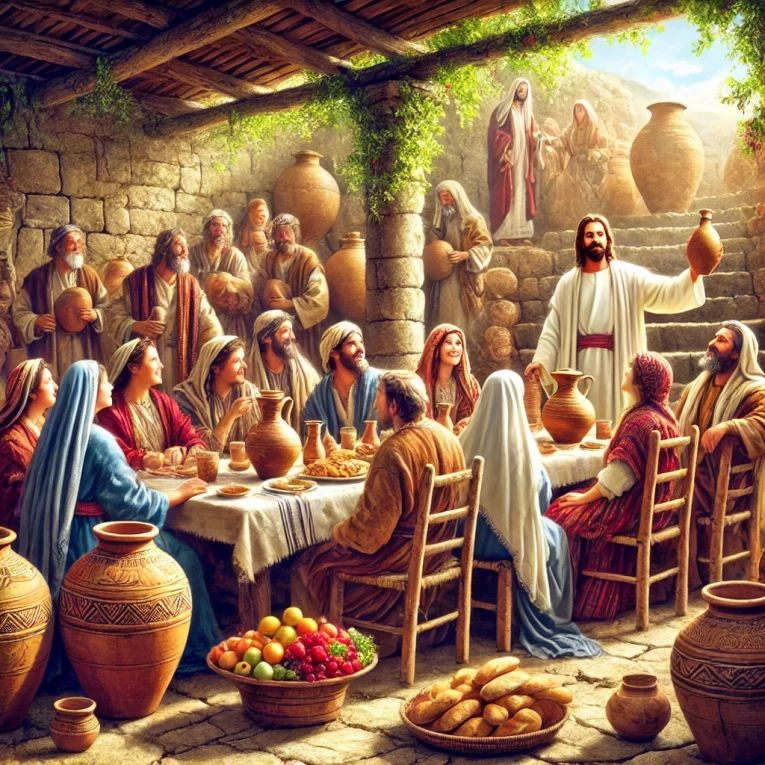
Subject: Jesus’ First Miracle: Turning Water into Wine at Cana
Opening Prayer
Heavenly Father, we come before You with grateful hearts for the gift of Your Word. As we study this passage, help us to see Your glory and understand the significance of Jesus’ first miracle. May we grow in faith and learn to trust in Your provision and timing. In Jesus’ name, we pray. Amen.
Summary and Key Theme
- Book Overview: The Gospel of John emphasizes the divine identity of Jesus Christ and His purpose to bring salvation to the world. Through seven key miracles and the “I AM” statements, John highlights Jesus as the Son of God.
- Chapter Summary: In John 2:1–12, Jesus performs His first recorded miracle at a wedding in Cana, turning water into wine. This miracle reveals His glory and begins His public ministry. It demonstrates His authority, compassion, and power, and it points to His ultimate mission: bringing new life to those who believe in Him.
Scripture Breakdown
- Verses 1–2 (NIV): 1 On the third day a wedding took place at Cana in Galilee. Jesus’ mother was there, 2 and Jesus and his disciples had also been invited to the wedding.
- The Setting: A Wedding in Cana (John 2:1–2, NIV)
- Jesus and His disciples are invited to a wedding, emphasizing His participation in ordinary human life.
- Weddings in Jewish culture were significant social events lasting several days.
- The presence of Jesus at this celebration reveals His value for relationships and community.
- Cultural Insight: Jewish weddings often lasted up to a week and were community-wide events.
- The Setting: A Wedding in Cana (John 2:1–2, NIV)
- Verses 3–5 (NIV): 3 When the wine was gone, Jesus’ mother said to him, “They have no more wine.” 4 “Woman, x why do you involve me?” Jesus replied. “My hour has not yet come.” 5 His mother said to the servants, “Do whatever he tells you.
- The Problem: The Wine Runs Out (John 2:3, NIV)
- Mary informs Jesus that the wine has run out, which would have been a major social embarrassment for the hosts.
- This moment highlights the humanity of the situation and Mary’s faith in Jesus’ ability to help.
- It introduces the theme of Jesus’ compassion and His ability to meet human needs.
- Jesus’ Response: His Hour Has Not Yet Come (John 2:4–5, NIV)
- Jesus responds to Mary, “Woman, why do you involve me? My hour has not yet come,” indicating that His ultimate mission was not to perform miracles but to fulfill God’s redemptive plan.
- Mary’s instruction to the servants, “Do whatever he tells you,” reflects her trust in Jesus.
- This dialogue shows the importance of obedience to Christ’s direction.
- Greek Word: “Hour” (Strong’s G5610, hōra) refers to an appointed time, emphasizing God’s sovereign plan.
- The Problem: The Wine Runs Out (John 2:3, NIV)
- Verses 6–9 (NIV): 6 Nearby stood six stone water jars, the kind used by the Jews for ceremonial washing, each holding from twenty to thirty gallons. 7 Jesus said to the servants, “Fill the jars with water”; so they filled them to the brim. 8 Then he told them, “Now draw some out and take it to the master of the banquet.” They did so, 9 and the master of the banquet tasted the water that had been turned into wine. He did not realize where it had come from, though the servants who had drawn the water knew. Then he called the bridegroom aside
- The Miracle: Water Turned to Wine (John 2:6–9, NIV)
- Jesus instructs the servants to fill six stone jars with water, which He transforms into wine.
- The Greek word for “draw” (Strong’s G501, antleō) refers to drawing water, symbolizing Jesus’ active role in transformation.
- The quality of the wine astonishes the master of the banquet, symbolizing the abundance and excellence of God’s provision.
- The quality of the wine represents the richness of God’s provision through Jesus.
- The jars used for purification are repurposed for Jesus’ miracle, symbolizing the transition from old rituals to new life in Christ.
- Historical Insight: These jars held significant amounts of water, indicating the abundance of the miracle.
- The Miracle: Water Turned to Wine (John 2:6–9, NIV)
- Verses 10–12 (NIV): 10 and said, “Everyone brings out the choice wine first and then the cheaper wine after the guests have had too much to drink; but you have saved the best till now.” 11 What Jesus did here in Cana of Galilee was the first of the signs through which he revealed his glory; and his disciples believed in him. 12 After this he went down to Capernaum with his mother and brothers and his disciples. There they stayed for a few days.
- The Result: Jesus Reveals His Glory (John 2:10–12, NIV)
- This miracle is described as the first of Jesus’ signs, revealing His glory and leading His disciples to believe in Him.
- It foreshadows the joy and abundance of the Messianic kingdom.
- The passage concludes with Jesus, His family, and His disciples traveling to Capernaum, signaling the start of His public ministry.
- Travel Distance: The distance from Cana to Capernaum is approximately 16 miles (26 kilometers), a journey that would typically take about a day on foot in the first century.
- The Result: Jesus Reveals His Glory (John 2:10–12, NIV)
Practical Application
- Trusting in Jesus’ Timing: When Mary tells Jesus about the lack of wine, His response seems cautious: “My hour has not yet come” (John 2:4). Yet, He acts in perfect timing. This reminds us to trust God’s timing in our lives, even when we feel urgent about our needs.
- Faith in Action: Mary’s faith stands out—she trusts Jesus will handle the situation, even without knowing how. Her words, “Do whatever he tells you,” invite us to place our faith in Jesus and follow His guidance, even when we don’t fully understand His plans.
- Transformation in Christ: Jesus turns water into wine, transforming something ordinary into something extraordinary. In the same way, He can transform our lives, filling us with joy, purpose, and newness. This invites us to reflect on areas where we might need His transformative power.
- God’s Abundance: The miracle isn’t just sufficient; it’s abundant. Jesus provides more wine than needed, and it’s of the finest quality. This reminds us of God’s generosity and encourages us to rely on His provision in our spiritual and practical lives.
- Quiet Faithfulness: The miracle happens behind the scenes. Most guests don’t even realize what’s happened, but the servants and disciples see His glory. This shows that God often works in quiet, unseen ways in our lives.
Parallel Bible References
- The Messianic Banquet (Isaiah 25:6–9, NIV), The abundance of wine at Cana reflects the joy of the Messianic banquet foretold in Isaiah.
- Elisha’s Miracle of Oil (2 Kings 4:1–7, NIV), Both miracles demonstrate God’s ability to provide abundantly in times of need.
- Jesus Feeds the 5,000 (John 6:1–14, NIV), Like the wedding at Cana, this miracle reveals Jesus’ power and compassion.
- The New Covenant in Christ’s Blood (Luke 22:20, NIV), The wine at Cana symbolizes the new covenant and the joy of salvation in Christ.
- The Living Water (John 4:10–14, NIV), Jesus’ provision of wine parallels His offer of living water, symbolizing eternal life.
Interesting Historical, Archaeological, and Cultural Insights
- Jewish Weddings: These were major community events symbolizing joy and covenant relationships. Running out of wine would have been a significant social failure.
- Stone Water Jars: Used for purification rituals, these jars reflect Jewish traditions and the transformative power of Jesus.
- Cana of Galilee: Archaeological studies identify Cana as a small village, emphasizing the humble setting of Jesus’ first miracle.
- Wine Symbolism: In Jewish culture, wine symbolized joy and blessing, making it fitting for this first miracle.
- Signs in John’s Gospel: The term “signs” emphasizes miracles as demonstrations of Jesus’ divine authority and mission.
Group Discussion Questions
- How does Jesus’ presence at the wedding reflect His care for ordinary aspects of life?
- Example: In Matthew 6:31–33, Jesus teaches that God provides for our everyday needs.
- What does this miracle teach us about trusting God’s timing?
- Example: Ecclesiastes 3:1 reminds us that God’s plans unfold in His perfect timing.
- How can we “do whatever He tells us” in our daily lives?
- Example: James 1:22 calls us to be doers of the Word, not just hearers.
Weekly Challenge
Identify one area where you need to trust God more deeply. Take a step of faith this week by surrendering that situation to Him in prayer and obedience.
Closing Prayer
Father, thank You for revealing Your glory through Jesus and His miracles. Help us to trust in Your provision and timing, and may we live in obedience to Your Word. Guide us this week to reflect Your love and glory in our lives. In Jesus’ name, we pray. Amen.
Personal Homework
- Write a one-page reflection on what this miracle teaches you about faith and obedience.
- Memorize John 2:11 and meditate on its meaning throughout the week.
- Research the cultural significance of Jewish weddings and how it deepens your understanding of this passage.
Additional Resources
- NIV Study Bible – Provides verse-by-verse commentary and historical insights.
- Matthew Henry’s Commentary – Offers in-depth theological analysis.
- Strong’s Concordance – For Greek word studies like “hour” (G5610).
- BlueLetterBible.org – Online tools for word studies and cross-references.
- The Gospel of John by F.F. Bruce – A detailed commentary on John’s Gospel.

